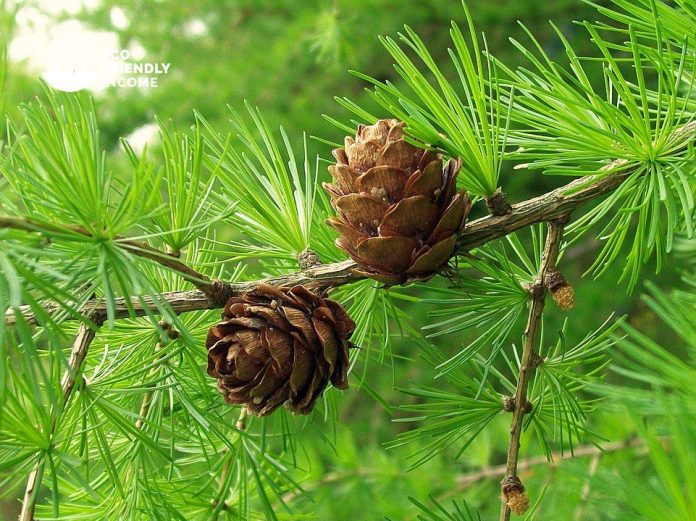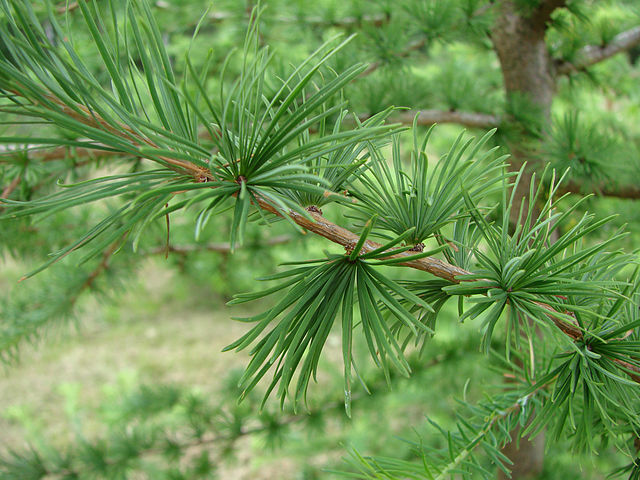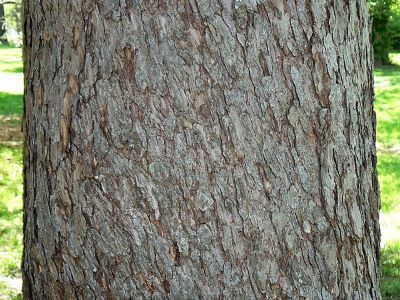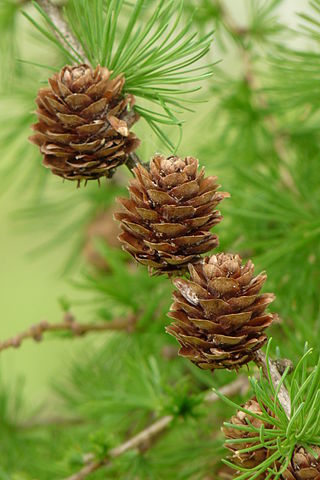
Featured Photo by Peter Connor / CC BY-SA 2.0
A field guide on how to identify and propagate European Larch (Larix decidua), a hardy tree that is native to the Alps and Caucasian mountains in Europe.
How to Identify European Larch (Larix decidua)
Leaves

European larch needles are linear-shaped, with entire margins (smooth). They grow on the stems in fascicle structures that grow in alternate arrangements.
Bark

The bark of young western larch trees is gray and scaly, while the bark on older trees is brown with deep cracks that reveal a reddish-brown inner layer.
Cones

Mature seed cones are firm and stand upright on branches.
Pollen cones hang down from the branches and are yellow or reddish-brown in color.
In the spring, the immature seed cones show gorgeous red to pink colors.
Flowering Season
The gorgeous colors of larch seed cones appear in the spring and continue to grow during summer.
Seed cones are ready to pick by late summer to fall.
Habitat
It grows quite well in and naturalizes much of the European mountain ranges.
You can find it in sites with plenty of light, and well-drained soils.
Some other understory plants that associate with European larch are:
- Rusty-leaved Alpenrose (Rhododendron ferrugineum)
- Red Elderberry (Sambucus racemosa)
- Victory Onion (Allium victorialis)
Wildlife Value
If you observe a European larch, you might see that its seeds are a tasty treat for red squirrels and a variety of birds, such as siskins and lesser redpolls.
Additionally, the buds and developing cones are enjoyed by black grouse.
The leaves of the larch also serve as food for the caterpillars of moths like the case-bearer and larch pug.
How to Propagate European Larch (Larix decidua)

Hardiness Zone: 2-5

Soil Type: Clay, loam, sand.

Water: Normal to High.

Exposure: Full Sun
You can propagate European larch with two effective methods:
- Stem Cuttings: It provides established trees faster, but is tricky, and will probably have a lower success rate.
- By Seed: The success rate is high but takes longer to get established saplings.
I’ve tried cuttings and have had a low success rate as compared to seeds.
That’s why I recommend seeds, but if you insist on stem cuttings, perhaps take a look at a propagation guide on the subject.
How to Propagate European Larch (Larix decidua) by Seed
Seed propagation is a popular and effective method for growing European larch trees.
With a few simple steps, anyone can successfully propagate these majestic trees and enjoy their beauty for years to come.
In this section, we will guide you through the process of collecting, stratifying, and planting European larch seeds to ensure the best chance of successful germination.
How to Harvest Seeds
Harvesting the cones of the European larch is a simple process that can be done in late summer to fall, or mid to late winter.
The best time to harvest the cones is during mid to late winter, when they have already gone through the stratification process and are ready to be used.
Note: In winter, they might have already lost most of their seeds to the wind!
If you don’t have access to seeds, you can always order some online at Mount Royal Seeds.
Here’s what you can do to get started:
- Pick the cones: Look for cones that are brown and ready to be harvested. You can pick them off the tree or gather them from the ground.
- Place the cones in a brown bag: After you’ve gathered the cones, place them in a brown paper bag and let them dry out. They’ll naturally open, it shouldn’t take long but if you want to hasten it, putting them in an oven at low temperature will open them right away.
- Knock the seeds out of the cones: Once the cones have opened, you can easily remove the seeds by knocking them out with a stick or your hand.
Stratification & Sowing
To prepare European larch seeds for planting, you can use the cold stratification method:
- Start by mixing the seeds with either moist sand or peat moss, and put the mixture in a labeled plastic bag (don’t forget to add the name and date).
- Store the bag in a freezer for 30 days.
- After 30 days, remove the bag from the freezer.
- Soak the seeds in warm water for a whole day to soften their outer layer.
- Store the seeds in the refrigerator for an additional 14 days.
- During this time, make sure to check the seeds occasionally to ensure that the sand or peat moss stays moist.
After the seeds have been stratified, it’s time to plant them. Mix peat moss and sand together to create a soil mix that drains well, and then plant the seeds.
Keep the soil moist to encourage germination.
They should germinate within a week. Congrats!
FAQ
Q: How fast does European larch grow?
A: Young trees establish rapidly and grow robustly, with an average yearly growth of 12 to 18 inches.
Q: Do European larch lose their needles?
A: Yes, larch is the only conifer tree that loses its needle annually. It’s actually a wonderful sight since the needles turn a golden yellow before falling off.
Q: Is Larix decidua a conifer?
A: Yes, while it does lose its needles annually, it is still a coniferous tree.
Q: Does larch like full sun?
A: Yes, they will actually thrive in it, larch trees in general have a longer growing season than other conifers. A lot of sunlight will help them grow fast.
